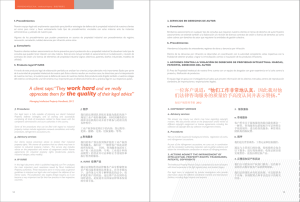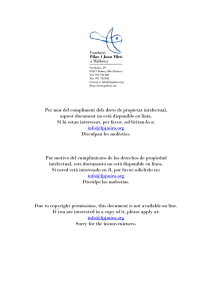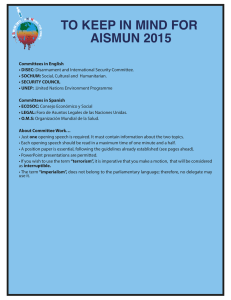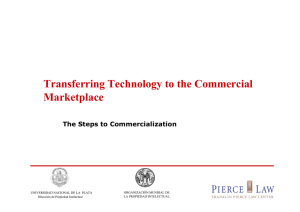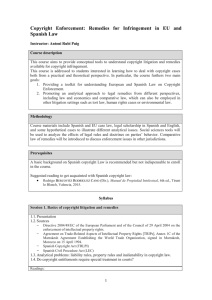Transferring Technology to the Commercial Marketplace
Anuncio
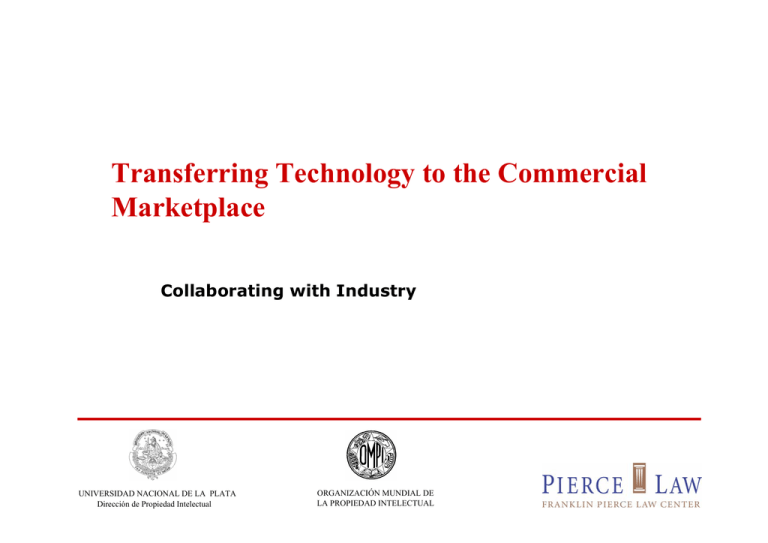
Transferring Technology to the Commercial Marketplace Collaborating with Industry UNIVERSIDAD NACIONAL DE LA PLATA Dirección de Propiedad Intelectual ORGANIZACIÓN MUNDIAL DE LA PROPIEDAD INTELECTUAL University-Industry Relationships in the U.S.: The Many Options Single sponsor/single SOW research projects Consortia (many companies funding together) Cooperative Research (government funded with company) Master/Umbrella Agreements Long-term Alliance Agreements Joint Studies/no cost Visiting Scientist Exchange Agreements Material Transfer Agreements UNIVERSIDAD NACIONAL DE LA PLATA Dirección de Propiedad Intelectual ORGANIZACIÓN MUNDIAL DE LA PROPIEDAD INTELECTUAL Standardized Terms Generally Found Inventions are owned according to U.S. patent law • Mine, yours, ours • No accounting or licensing approvals required where patents are jointly owned through co-inventorship • Invention ownership is not assigned to industry: fairly universal rejection by universities of “we paid for it so we own it” philosophy Same with copyrights and all other IP Publication delays only for sponsor confidential information and potential patents • Usually a 90 day limit UNIVERSIDAD NACIONAL DE LA PLATA Dirección de Propiedad Intelectual ORGANIZACIÓN MUNDIAL DE LA PROPIEDAD INTELECTUAL More Standardized Terms Research sponsors do receive license grants • Most common: Royalty-free, non-exclusive license without right to sublicense; option to negotiate a royalty-bearing exclusive license • Uncommon: Royalty-bearing license to be negotiated • Middle ground: Royalty-free, non-exclusive for non-commercial purposes Royalty rates • Most common: Fair and reasonable to be negotiated • Uncommon: Pre-set in research agreement • Possible middle ground: Floor > Ceiling set in research agreement UNIVERSIDAD NACIONAL DE LA PLATA Dirección de Propiedad Intelectual ORGANIZACIÓN MUNDIAL DE LA PROPIEDAD INTELECTUAL And, More Standardized Terms Who Files? • Common: University files through patent counsel of choice • Not quite so common: University permits industry sponsor to file provided university has right of review and comment • Issue: Who is the client? UNIVERSIDAD NACIONAL DE LA PLATA Dirección de Propiedad Intelectual ORGANIZACIÓN MUNDIAL DE LA PROPIEDAD INTELECTUAL And, More Standardized Terms Payment of patent costs • Most common: Sponsor/licensee to pay if license is exclusive • Uncommon: University undertakes obligation to file and always pays • Middle ground: Sponsor to pay to ensure patent application is filed; otherwise discretionary with university UNIVERSIDAD NACIONAL DE LA PLATA Dirección de Propiedad Intelectual ORGANIZACIÓN MUNDIAL DE LA PROPIEDAD INTELECTUAL Identifying Clauses That Play a Role in Technology Transfer The parties (who will be the “licensee” if IP is developed) Typical clauses involving intellectual property rights/obligations • Definitions of “invention” and other IP • Requirement to disclose • Patent filing obligations; foreign filing elections and who pays UNIVERSIDAD NACIONAL DE LA PLATA Dirección de Propiedad Intelectual ORGANIZACIÓN MUNDIAL DE LA PROPIEDAD INTELECTUAL Identifying Clauses That Play a Role in Technology Transfer • Typical clauses involving intellectual property rights/obligations • License rights- patents/copyrights/software/trp o Vesting under research contract (“hereby grants” vs. “agrees to grant”) o Option periods o License terms • Background rights • IP warranties, representations UNIVERSIDAD NACIONAL DE LA PLATA Dirección de Propiedad Intelectual ORGANIZACIÓN MUNDIAL DE LA PROPIEDAD INTELECTUAL The Background Rights Dilemma Background rights – rights to university’s pre-existing, concurrently developed and in some cases “to be developed” IP outside of the scope of the research program. Typical clause requires university to give/license the sponsoring company rights to use any other IP owned by the university that is necessary for/useful for practicing inventions/copyrights or all research results developed during the project. Right is usually open-ended – no time limit on the obligation or exercise of it UNIVERSIDAD NACIONAL DE LA PLATA Dirección de Propiedad Intelectual ORGANIZACIÓN MUNDIAL DE LA PROPIEDAD INTELECTUAL The Problem with Background Rights: A Clearer View Impossible to speculate what university IP will be encumbered because: • Invention to which background rights are tied hasn’t been made yet • Impossible to know how the sponsor may at some future time use an invention, copyright or other research result Provides industry with entitlement to unfunded IP Ties up IP developed by investigator who never took sponsor funding –diminishes the rights/expectations of unsuspecting inventor UNIVERSIDAD NACIONAL DE LA PLATA Dirección de Propiedad Intelectual ORGANIZACIÓN MUNDIAL DE LA PROPIEDAD INTELECTUAL The Problem with Background Rights: A Clearer View Guts university tech transfer program because background is not licensed for benefit of the public (but is used defensively for benefit of a single company). Requires collateral IP (if identifiable) to be put “on hold” Impacts future sponsored research. One company’s background is anther company’s reason to sponsor UNIVERSIDAD NACIONAL DE LA PLATA Dirección de Propiedad Intelectual ORGANIZACIÓN MUNDIAL DE LA PROPIEDAD INTELECTUAL Crawling Out of the Background Rights Dilemma Limit to inventions of named research team – not entire university Limit to “required” for commercialization of licensed inventions – not “useful” for commercialization of research results Limit to “extent university has right to license” Put time limitation on – e.g. inventions made one year after termination of research contract Require royalties to be paid; no consideration for royalty-free UNIVERSIDAD NACIONAL DE LA PLATA Dirección de Propiedad Intelectual ORGANIZACIÓN MUNDIAL DE LA PROPIEDAD INTELECTUAL
